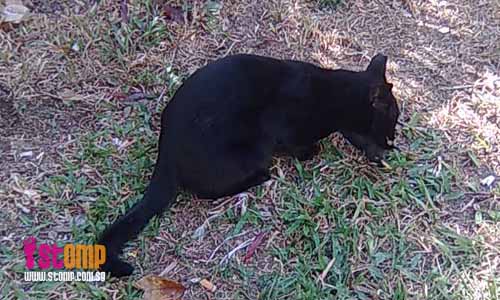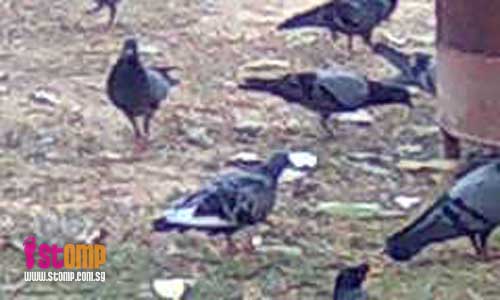
This black cat was observed playing with a bird near a coffee shop at Seng Poh Road. Not long after the cat seemed to let it go, and the bird flew away apparently unharmed.
STOMPer karkarlai relates what he saw:
"I observed this cat playing with a bird yesterday (Jan 20) at 12.45pm, along Seng Poh Road off Tiong Bahru.
"I was having lunch with some of my friends at a coffee shop there. To our surprise we saw a black cat having fun with this bird. A few minutes later, the bird flew away.
"Very interesting!"


I am sure the bird did not find the whole experience very 'cute'.
There are various hypotheses as to why cats to play with their prey. One possibility is that seeing smaller animals triggers the predatory instinct, even in cats that are well-fed and have no need to hunt for survival. Playing with their prey is thus seen as an instinctive response.
Or maybe it is merely an extension of the play behaviour exhibited by kittens. Play in predatory mammals is often a means for youngsters to hone their skills in catching and subduing prey, so maybe adult cats that play with their prey are just getting in touch with their inner kitten.
Of course, there is always the possibility that cats are just plain mean and evil.
Domestic cats and the threat they pose to wildlife are the focus of much debate. In countries where they have turned feral, such as in Australia and New Zealand, they prey heavily on vulnerable species that have yet to adapt to the arrival of this predator. Even in North America and the United Kingdom, there is a lot of concern about the heavy toll on birds and small mammals.
There are a number of interesting anecdotes over at the Bird Ecology Study Group, with victims such as Javan mynah (Acridotheres javanicus), Asian paradise flycatcher (Terpsiphone paradisi), cinnamon bittern (Ixobrychus cinnamomeus) and collared kingfisher (Todiramphus chloris).
And a couple of days ago, there was an interesting series of messages left by my friends on Twitter:
sivasothi:Will be collecting a tree shrew specimen from a friend's fridge next Tue after a field trip - it was a victim of his cat, apparently. - 12:36 PM Jan 18th
kungfubunny: @sivasothi my cats killed a shrew a few weeks ago too. let me know if dismembered skinks, lizards and roaches interest you. - 10:12 PM Jan 18th
sivasothi: One dead tree shrew (RIP), safely deposited in department's deep freezer. Label reads: "Collector: Ivan Polunin's cat." - 7:10 PM Jan 20th
There are many strategies to reduce the impact of domestic cats on wildlife, but the best solution is ultimately to reduce the number of cats stalking around outdoors. The numbers of strays should be reduced through a system of sterilisation and adoption of suitable candidates. Abandonment of pets should be frowned upon, and perpetrators severely penalised. Housepets should not be allowed to wander and roam outside, not only for the sake of the wildlife, but also for the cats' own safety. In an ideal situation, the number of cats present to prey on wildlife would hence be greatly reduced.
Management of cat populations is certainly a very contentious issue; I strongly feel that stray cats have every right to share our neighbourhoods, and that a lot more ought to be done to promote a society more tolerant of the existence of other non-human species. A lot of the hatred and paranoia towards cats in Singapore is unwarranted and undeserved, and cat 'problems' are more often than not human problems - whether it's pet abandonment, irresponsible feeding, animal abuse, intolerance, or laws on ownership, these issues are more about people and their attitudes towards cats. Below are some recent letters to the press, regarding the presence of cats in our residential and recreational areas:
Time to revive Stray Cats Rehabilitation Scheme (18th December 2008)
Cats in HDB flats: Don't punish responsible pet owners (2nd January 2008)
Stray cats a pest at former Big Splash (16th January 2008)
Pests: Beware aggressive felines at seafood centre (20th January 2008)
Teach kids to have some empathy for stray cats (20th January 2008)
UPDATE: Managing cats in East Coast Park: Cat Welfare Society responds to letters (23rd January 2008)
UPDATE: What SPCA is doing about stray cats at East Coast Park (23rd January 2008)
It is good to see that there are people out there willing to speak up in defence of the cats. I personally feel that there is so much more that can be done with regards to how cat issues are managed; the various volunteer-driven programs could do with a lot more support from government bodies, while a lot more education needs to be done to debunk a lot of blatantly false information about cats. And of course, some people just need to get over their fear and paranoia of cats. It's not as if we are being stalked by leopards and cougars, which people living in cities elsewhere have to deal with.
At the same time, it cannot be denied that in certain situations, when the long-term survival of other species is at stake, certain drastic measures to intensively manage the cat population may have to be taken, including culling, which I feel is a viable solution only if all other non-lethal alternatives have been fully explored and ruled out.
Fortunately, the situation does not seem so dire in Singapore; cat populations are largely concentrated around urban areas, so the impact of predation by stray and domestic cats on threatened species should be quite limited. Hopefully, we will never need to contend with such an extreme scenario, one that would polarise cat lovers and nature lovers in Singapore.